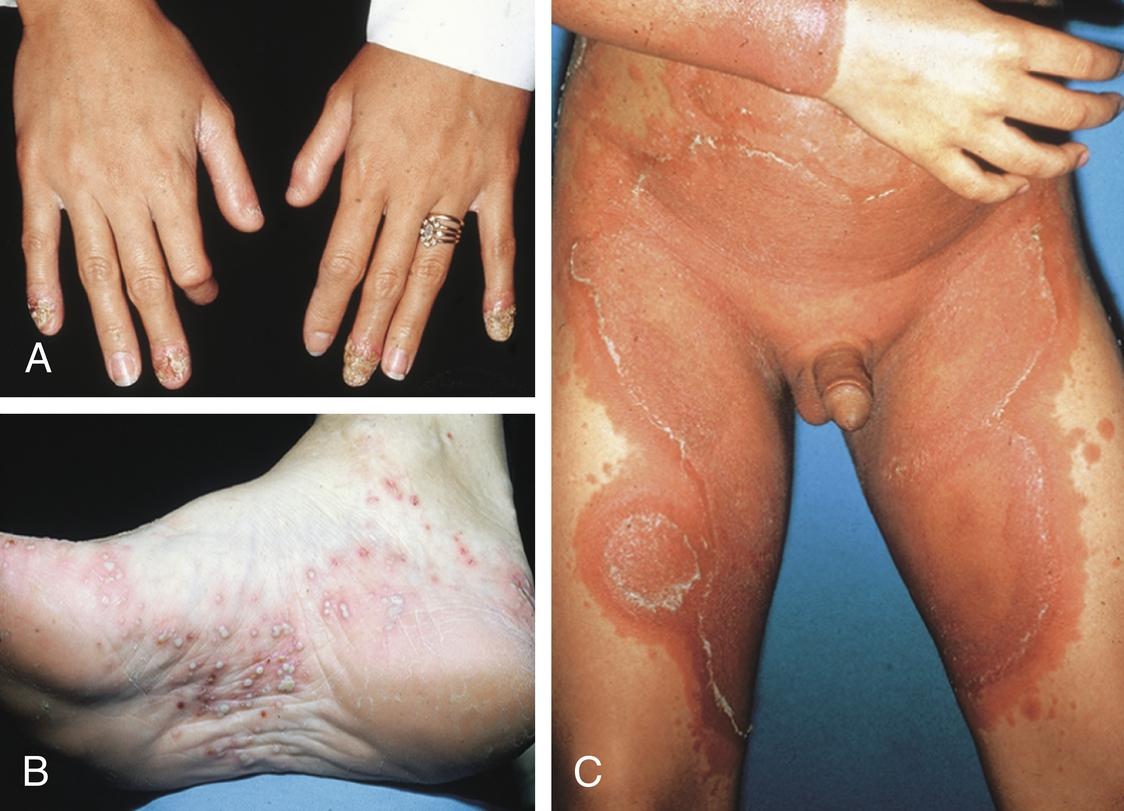Physical Address
304 North Cardinal St.
Dorchester Center, MA 02124
A pustule is a purulent vesicle or bulla. Whereas a vesicle contains clear or translucent fluid, a pustule is filled with neutrophils or, less commonly, eosinophils. Pustules are one of the primary lesions in skin. Most pustular eruptions begin as pustules, but others may pass through a transitory stage in which they appear vesicular (vesiculopustules).
Pustules may be classified on the basis of where the acute inflammatory cells accumulate (e.g., subcorneal, follicular, sweat duct), pathogenesis (e.g., infectious, autoimmune), predominant inflammatory cells (e.g., neutrophils, eosinophils), and clinical presentation ( Table 11.1 ). Pustules may be unilocular or multilocular.
| Pathogenesis | Site of accumulation |
|---|---|
| Autoimmune | |
| IgA pemphigus | Subcorneal |
| Infectious | Variable |
| Candidiasis | Subcorneal |
| Furuncle/carbuncle | Follicular |
| Impetigo | Subcorneal |
| Hot tub (pseudomonal) folliculitis | Follicular |
| Kerion (tinea capitis) | Follicular |
| Pityrosporum folliculitis | Follicular |
| Vaccinia infection/vaccination | Intraepidermal |
| Inherited | |
| Pustular psoriasis | Subcorneal, intraepidermal |
| Reiter's syndrome | Subcorneal, intraepidermal |
| Drug Eruptions | |
| Acneiform drug-induced eruptions | Follicular |
| Acute generalized exanthematous pustulosis | Subcorneal |
| Halogenodermas | Intraepidermal |
| Miscellaneous | |
| Acne necrotica miliaris | Follicular |
| Acne vulgaris | Follicular |
| Arthropod reactions | Intraepidermal |
| Erythema toxicum neonatorum | Follicular |
| Eosinophilic pustular folliculitis | Follicular |
| Folliculitis decalvans | Follicular |
| Infantile acropustulosis | Subcorneal, intraepidermal |
| Miliaria pustulosa | Sweat duct |
| Pustular bacterid | Intraepidermal |
| Rosacea | Follicular |
| Subcorneal pustular dermatosis | Subcorneal |
| Transient neonatal pustular dermatosis | Subcorneal |
Acne vulgaris, although not all lesions in this condition are pustular ( Fig. 11.1 ). The infectious pustular eruptions are also common (see Chapter 27 ).

Pustular psoriasis may be broadly subdivided into localized and generalized forms. Localized pustular psoriasis may occur on any site and may also occur within plaques of classic psoriasis. Distinctive variants include acrodermatitis continua of Hallopeau ( Fig. 11.2 A ), which is characterized by pustules and crusting of the distal fingers and toes and localized pustular psoriasis of the palms and soles ( Fig. 11.2 B). It is unclear whether pustular eruptions confined to the palms and soles represent a form of localized psoriasis or a different disease called pustular bacterid. Variants of generalized pustular psoriasis include generalized pustular psoriasis of von Zumbusch, exanthematic generalized pustular psoriasis, and impetigo herpetiformis. The von Zumbusch variant presents as generalized pustules in patients with preexisting plaque-type psoriasis or erythrodermic psoriasis. Exanthematic generalized pustular psoriasis arises suddenly without preceding psoriasis ( Fig. 11.2 C). Impetigo herpetiformis is associated with pregnancy. Hypocalcemia is also frequently present (see Chapter 59 ).

The most important inciting factor is the administration of systemic corticosteroids. In a study of 104 patients, corticosteroids were implicated as the precipitating factor in 37 patients (36%). This association is one of the primary reasons that psoriasis is not treated with systemic corticosteroids. Less common precipitating factors included infection (13%), hypocalcemia (9%), pregnancy (3%), and other drugs (e.g., terbinafine, lithium).
Baker H, Ryan TJ. Generalized pustular psoriasis: a clinical and epidemiologic study of 104 cases. Br J Dermatol. 1968;80:771–793.
Most treatments that are used on classic plaque-type psoriasis can also be used for the management of pustular psoriasis. The National Psoriasis Board reviewed the literature and concluded that the quality of literature was weak but did make recommendations to divide treatment into first-line and second-line treatments. First-line treatments include acitretin, cyclosporine, methotrexate, and infliximab. Second-line treatments include adalimumab, etanercept, and psoralen plus ultraviolet light (PUVA). Patients whose symptoms may have been induced or exacerbated by medications should have these withdrawn.
Robinson A, Van Voorhees AS, Hsu S, et al. Treatment of pustular psoriasis: from the Medical Board of the National Psoriasis Foundation. J Am Acad Dermatol. 2012;67:279–288.
Pustular bacterid (of Andrews) is a controversial clinical eruption. While many dermatologists consider it to be a form of pustular psoriasis localized to the palms and soles, new cases continue to be reported in the literature. As originally defined by Andrews, pustular bacterid is a pustular eruption of the palms and soles in which the patient has no history or other clinical signs of psoriasis. Rarely, the lesions may spread to other parts of the body. The lesions are induced by low-grade bacterial infection in occult or evident foci, such as the teeth, tonsils, or gallbladder. The pustular eruption totally resolves with eradication of the infection. A later study has noted that injected Candida antigen aggravated up to 37% of patients with this disorder, suggesting that this phenomenon may not be restricted to bacterial infections. The recent recognition of bacterial “superantigens” provides a possible immunologic mechanism for induction of this disorder.
Kamiya K, Ohtsuki M. Acute generalized pustular bacterid. J Gen Fam Med. 2018;19:32–33.
Become a Clinical Tree membership for Full access and enjoy Unlimited articles
If you are a member. Log in here